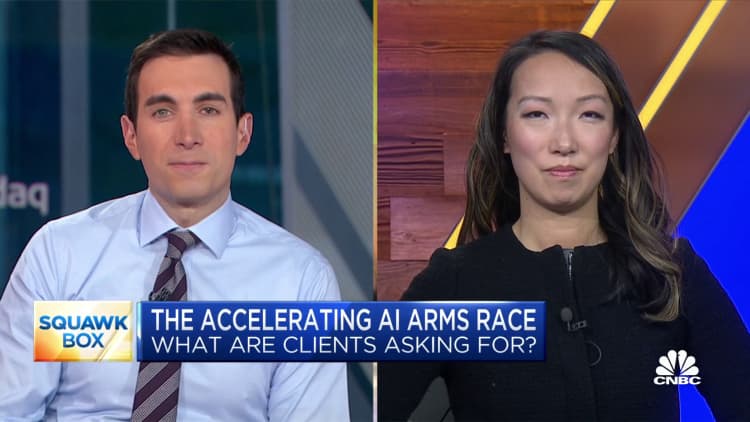For many companies, jumping into the world of rapidly evolving technology, like chatbots and generative artificial intelligence, can be scary.
Even so, OpenAI's ChatGPT, Microsoft's Bing AI, and Google's Bard are all in the spotlight, as companies invest in these large language models and the technology behind its human-like conversations.
In the world of HR and talent acquisition, ChatGPT and AI have the potential to reinvigorate the entire recruitment and retention experience for both candidates and employees, said Sultan Saidov, co-founder and president of Beamery, a global human capital management SaaS firm which has its own AI language model platform called TalentGPT.
"Historically, HR has been built around processes, rather than around people," he said. "The first question we should ask ourselves, when it comes to adopting AI and GPT technology, is, 'What does it take for companies to treat people like they treat their customers?'"
"Whether it's a candidate, employee, or manager, our experiences as consumers over the last decade, with or without AI, have become increasingly frictionless and personalized," he added.
As a result, companies need to move away from process-oriented systems and experiences, and instead use AI to create more personal experiences for candidates, employees, and any stakeholder within the company.
Candidates prefer a personable recruitment experience
Even with layoffs sweeping the labor market, companies continue to struggle with HR issues, like return-to-office mandates, lower productivity, disengagement, and retention.
Saidov suggests using AI and chatbots to help mitigate these issues, by incorporating them at the beginning of the employee journey: job applications and recruitment.
From screening resumes, scheduling candidate interviews, and supporting onboarding, AI can help at each stage of the candidate experience, says Sameer Penakalapati, CEO at Ceipal, an AI-driven talent acquisition platform.
"From the beginning, AI can screen and rank candidates by categorizing them into a ranking system for recruiters, and then chatbots can communicate with candidates through messaging about standard topics like compensation expectations," Penakalapati said.
"This creates an experience for candidates that's smooth," he added. "At the same time, recruiters and HR teams collect the information they need before connecting a candidate to a member of their team."
Speed and efficiency are integral to creating a more personal candidate experience, Penakalapati said, and AI and ChatGPT technology can help recruiters achieve this.
"Screening candidates is the biggest component of finding talent, and recruiters, hiring managers, and HR leaders only have limited time to fill positions for their organizations," Penakalapati said. Chatbots can dramatically cut down the amount of time it takes to review resumes and identify candidates that are ready to move onto the next stage of the job interview.
With the incorporation of these tools, a candidate can apply to a job and instantly get screened for a position, and the first conversation between a candidate and recruiter can be focused on personality and fit with a company's culture, Penakalapati said.
Workers will stay at companies with employee-focused experiences
Whether it results in falling productivity or quiet quitting, employees point back to their company's internal, and sometimes outdated, processes as a contributor for leaving or not staying engaged. Some experts already see VR and AI as game changers for these issues.
Saidov said companies need to invest in their employees' experiences the same way they invest in their customers.
He likens the situation to the way consumers use Google Maps, explaining that "It tells you exactly how you get from here to there for a certain destination. For an employee trying to navigate choices in their company, nothing like that exists."
AI and chatbots could enable workers to see not only how their role fits in the bigger picture of the company, but also explore the exact pathways they can navigate to move up in their career, or move laterally into a new role, making them less likely to quit, Saidov said.
An employee working in marketing, for instance, would be able to ask a chatbot how they could become a product manager, complete with details on how others in the company made that career transition. AI would also enable that employee to learn what skills or education is needed for a different role.
"AI helps create this experience by helping workers access information about what is happening in the company in a very natural way," Saidov said. "It helps them see their future at a company and analyze the trajectories of people who started in similar roles as them."
AI can help increase diversity and inclusion
Deploying AI and ChatGPT can potentially help HR executives navigate diversity and inclusion challenges. Research shows growing unhappiness among workers, with Black workers among the most unhappy employees. Issues with pay transparency, a misalignment of personal values with company values, and a desire for more diverse leadership are the major reasons why Black employees are unsatisfied.
"The transparency that AI can provide in assisting with choices in the employee experience creates more than just a nicer experience," Saidov said. "It provides an opportunity to create more inclusion."
AI and chatbots can help increase inclusion by generating career pathways and matching candidates to jobs that are skills-centric versus education-centric. It can be a guide for disadvantaged workers in a company to level up their proficiency by giving them an opportunity to re-skill or upskill.
These platforms create more inclusion by creating better transparency and by giving employees more choices to make real career improvements, he adds.







